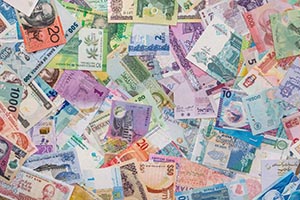
More payment options create checkout success

3 ways to make practical use of real-time payments

The COVID-19 pandemic had a dramatic effect on hospitality businesses, with the hotel industry experiencing a major setback. In March 2021, for example, U.S. hotel occupancy dropped to 53%, and revenue per available room had declined by 32.5%.
As corporations and government entities implemented remote work policies and canceled most business-related travel, consumers switched to leisure trips. Hotels with onsite restaurants that cater to their local communities introduced outdoor dining, delivery, and pickup to fill the gap left from business travelers.
Consumers chose to limit in-person interactions and turned to contactless and digital payment methods, many of which will be expected to continue post-pandemic due to the speed and convenience they bring to reservations, check-in, check-out, on-site purchases and delivery.
We sought to understand the impact of the pandemic along with the latest consumer payment method preferences in our inaugural 2021 Hotel Payments Insight Report, conducted in July 2021.
Hotel data and analytics firm STR is projecting that about 1 billion U.S. hotel rooms will be booked this year, up from 829 million in 2020, but still below the record year of 2019, when guests booked 1.3 billion rooms.
Hotel business-travel revenue for the year is expected to fall more than $59 billion compared with 2019, according to a report released last month by the American Hotel & Lodging Association. With corporate travel lagging, revenue per available room is not projected to return to pre-pandemic levels until 2023.
We asked our survey participants – all of whom had stayed at a hotel in the previous 12 months – the purpose of their most recent hotel stay:
The flexibility that comes with working from anywhere is changing weekend travel patterns to include Fridays and Monday as remote employees choose to work from a hotel on those days.
Most consumers surveyed, 55%, regardless of age group, opted to make reservations directly through a hotel’s website or mobile app. Third-party booking sites were a close second, but only for those under age 50.
When making reservations, credit cards are preferred by participants aged 51-65, while younger consumers opt for debit cards. Just over 40% of participants – mainly younger consumers – expressed an interest in paying via money transfer apps like Venmo®, Zelle® and PayPal®, as well as with digital wallets including Apple Pay® and Google Pay®.
About two-thirds of participants are members of hotel loyalty programs. For the vast majority, these loyalty programs do influence the way they book, with 66% specifically looking for hotels with their preferred loyalty program.
“It’s increasingly being proven that digital and contactless technology provides a more flexible and personalized experience for guests, ultimately proving to be a positive change.”
Advanced payment for upcoming reservations is acceptable by most recipients, but primarily on the condition of receiving a full refund should plans change. While 23% of those age 21-35 are comfortable with non-refundable advance payments, this drops to 6% among those age 51-65 and just 2% of the age 66+ cohort.
Interestingly, 65% of participants age 21-35 either somewhat or strongly agree that they would be willing to pay a small surcharge for the convenience of using a credit card to pay for a stay. This allows operators to offset the costs of credit card acceptance fees and allows guests the option to avoid the fee by switching to a debit card.
Prior to the pandemic, many hotels were dabbling with technologies such as digital check-in, kiosks, and mobile room keys. As consumers switched to contactless, curbside, and online interactions at grocery stores, retail shops and restaurants to reduce exposure to COVID-19, they became accustomed to the speed and convenience of digital experiences.
While some people believe going high-tech removes the personal touch, it’s increasingly being proven that digital and contactless technology provides a more flexible and personalized experience for guests, ultimately proving to be a positive change. People simply want to arrive and head to their rooms, as was reported by most participants, except those over age 66.
When paying for services or amenities during a hotel stay, about a quarter to a third of participants have used a digital wallet and/or a payment feature within the hotel app. Most guests used a credit or debit card to make purchases at a restaurant, bar or gift shop. However, about 60% of participants aged 21-50 would like to pay for non-room-related expenses from within the hotel’s mobile app.
As hotels, restaurants and other businesses pivoted quickly during the pandemic to help keep customers safe, QR codes skyrocketed in use – especially as a replacement for printed menus.
In a 2021 survey, 83% of respondents said they had used a QR code to process a payment for the first time within the last year, and 54% had their first experience with payment via QR code within the last three months.
There are recent signs that business travel is slowly gaining momentum. Group demand, which is a mix of business and leisure, grew 5.7% between the final two full weeks in September 2021, according to STR.
Business travelers will expect the amenities they always enjoyed, while welcoming new convenient check-in experiences that allow them to immediately access their rooms upon arrival.
The way we work has changed, and chances are that employees – especially younger workers who tapped into their wanderlust during the pandemic – will continue to embrace the combination of work and play while traveling.
Hotel operators should embrace the digital experiences and payment preferences of younger consumers. By rewarding them with personalized gifts and discounts, they can build the next generation of loyal guests, increasing lifetime value. Expanding payment options from within your website or mobile app increases stickiness, removes friction, and allows you to deliver a better “on us” experience.
Get a copy of the full 2021 Hotel Payments Insight Report and see results from our companion 2021 Restaurant Payments Insight Report.
Related content


